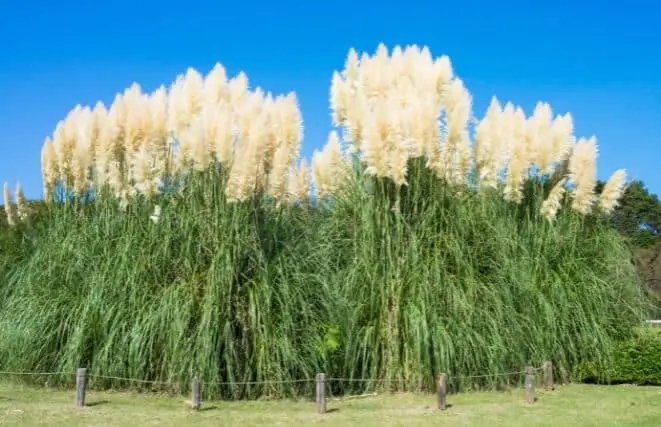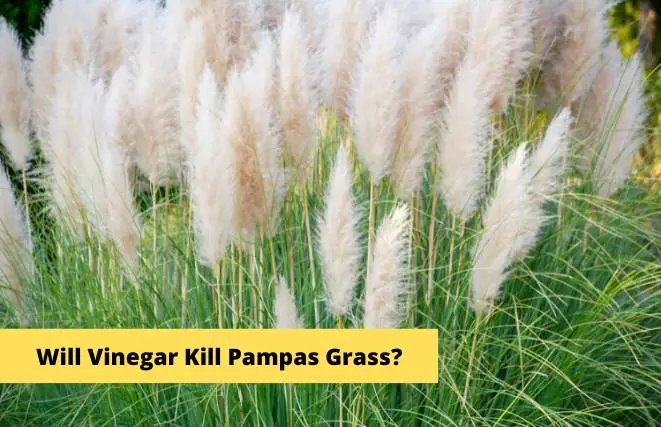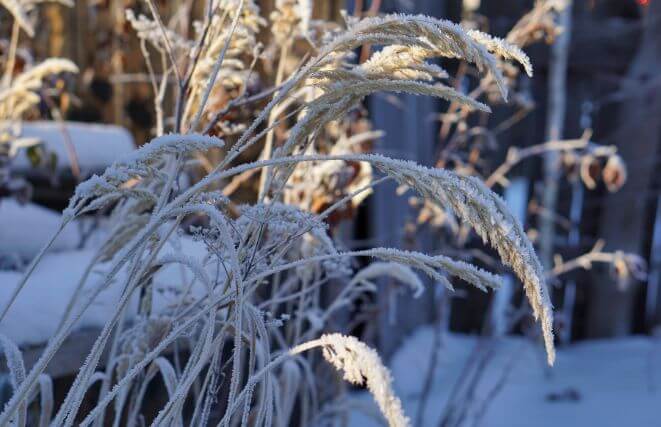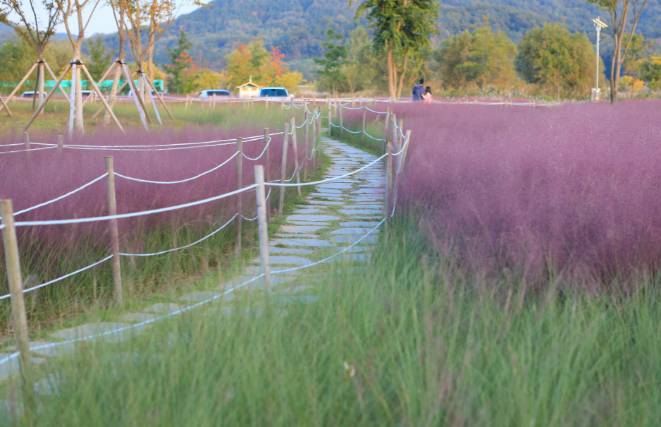White pampas grass (Cortaderia selloana) is a stunning ornamental grass with fluffy, feathery plumes that can reach up to 10 feet tall. It’s known for its striking white color and graceful, arching leaves. This variety of pampas grass is drought-tolerant and low maintenance, making it a popular choice for landscaping and adding texture and interest to gardens. However, it’s important to note that white pampas grass can be invasive in some areas, so it’s important to research local regulations before planting.
What is White Pampas Grass?
A native to southern South America, pampas grass hails from the Pampas region, which explains its name. It was planted in New Zealand, Australia, North America, and Europe in the 1970s and harvested for decorative purposes once these plants dried.
Recently, we have seen a massive resurgence in recent years, as these plants have grown in popularity among homeowners. However, pampas grass isn’t only used as a decorative addition to a home.
Pampas grass is easy to grow in varied conditions and works wonders as a privacy feature. It’s available in many different colors, including pink and beige, which only adds to its appearance. More homeowners are using pampas grass to shield their homes from outsiders.
It’s an excellent low-maintenance, drought-resistant, and easy-to-grow shrub that offers a striking appearance to any landscape. This is why many homeowners search for the best ways to grow and care for such vegetation.
Our helpful guide provides you with all the features you need to address when caring for this grass. From pruning to propagating, we’ve covered it all.
| Common Name | White Pampas Grass |
| Scientific Name | Cortaderia selloana ‘White Feather’ |
| Height & Spread | 6-10 ft tall and 3-6 ft wide |
| Sun Exposure | Full sun |
| USDA Growing Zones | Zones 7-10 |
| Water | Moderate watering |
| Soil Type | Well-drained soil |
| Soil pH | 6.0-7.5 |
| Pests & Diseases | Susceptible to rust and fungal diseases |
| Bloom Time | Late summer to early fall |
| Flower Color | White |
| Native Area | South America |
White Pampas Grass Zone
Pampas grass, also known as Cortaderia selloana, is popular in landscapes and well-liked for being an attractive ornamental grass. There’s no doubt that pampas grass is easy to grow. It can grow in harsh climates commonly found in Zone 6 regions while also thriving in USDA zones from Zone 7 and Zone 11. Nonetheless, it’s crucial to address what you’re signing yourself up for before you begin planting this grass.
In some cases, these feathery plumes can grow to become invasive, which is why you shouldn’t be too quick to plant this foliage in your garden until you address some considerations. A pampas grass plant is known to grow rapidly and can reach anywhere between 5 and 10 feet wide and high. Thus, offering the right care and maintenance is vital. Our helpful tips listed below can be used to address these considerations and ensure you get the best out of this pampas grass.

White Pampas Grass Maintenance
White pampas grass is a popular ornamental grass that can be found in many gardens. It requires minimal maintenance, but it does need to be trimmed every few years to keep it looking its best.
White pampas grass is a tropical grass that can grow up to 3 feet tall and wide and It has very few pests and diseases, making it a low-maintenance plant for most gardeners.
The only major thing you will need to do for your white pampas grass is trimming it every few years with hedge shears or a lawn mower, depending on how high you want the plant to grow.
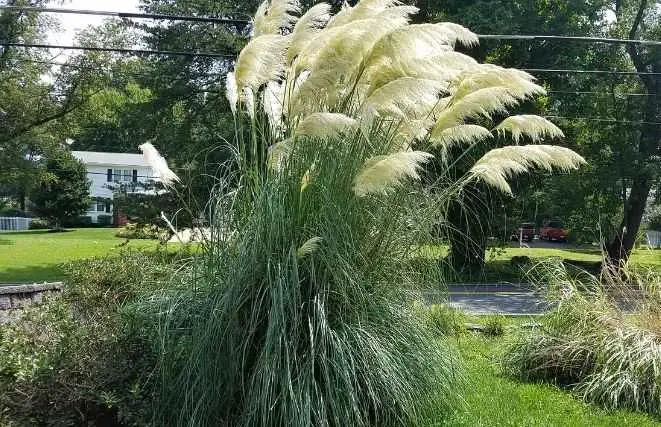
Is white pampas grass invasive?
Yes, white Pampas Grass (Cortaderia selloana) is considered invasive in many regions. While it is valued for its ornamental beauty and dramatic plumes, it has the potential to become an aggressive and problematic species in certain ecosystems. The plant’s invasive nature is attributed to its ability to establish and spread rapidly, outcompeting native vegetation and disrupting natural habitats.
Here are some reasons why white Pampas Grass is considered invasive:
- Rapid Growth: Pampas Grass can grow quickly, producing a large number of seeds that are easily dispersed by wind.
- Seed Dispersal: Its seeds can be carried over long distances by wind, water, and animals, allowing it to colonize new areas.
- Lack of Natural Predators: In non-native environments, Pampas Grass may lack the natural predators and diseases that keep it in check in its native habitat.
- Adaptability: It can thrive in a variety of soil and climate conditions, enabling it to establish in diverse environments.
- Displacement of Native Plants: Invasive Pampas Grass can outcompete and displace native vegetation, reducing biodiversity and disrupting local ecosystems.
- Fire Risk: Pampas Grass is highly flammable, posing a fire risk in areas prone to wildfires.
Due to these factors, many regions have listed white Pampas Grass as an invasive species and recommend avoiding its planting to prevent its negative impact on local ecosystems. If you’re considering planting Pampas Grass, it’s important to research and ensure that it’s not considered invasive in your area.
Caring for White Pampas Grass
Before you begin growing this foliage in your garden, you should search for a generous space in your landscape to allow for the planting to grow. This is especially true if you plan on growing multiple plants.
Mass planting pampas grass typically requires you to space this foliage 6 to 8 feet apart. Additionally, pampas grass is known for thriving in full sun conditions. However, it can tolerate being planted in areas with partial shade.
This white foliage can also handle a wide array of soil conditions. However, the most suitable type and one you should search for is moist, well-draining soil. A massive advantage of planting pampas grass is that it’s tolerant to drought conditions, salt sprays, and wind. Thus, it’s a common plant in coastal regions.
How to Grow White Pampas Grass?
Once you’ve established your planting in full sun or partial shade conditions, it requires minimal care and maintenance. However, you should conduct a regular watering schedule if your pampas grass is planted in extreme drought conditions.
Moreover, this pampas grass plant should be pruned every year to the ground. You generally do this in late winter or early spring. When pruning your pampas grass, we recommend doing so with great care and while wearing a long-sleeve shirt and gloves, as the plant has sharp foliage.
You also have the option of burning this pampas grass down to its green growth as an alternative to pruning this shrub.
When doing this, you should address some safety considerations and ensure that these clumps are far away from any building or homes. Finally, you can use a balanced fertilizer after pruning to help stimulate growth. However, this isn’t mandatory.
How to Propagate Pampas Grass?
Pampas grass can be propagated through division in the spring months. During the process of propagation, its pruned clumps are sliced through with a shovel and planted in moist, well-draining soil. Only female pampas grass is generally propagated. These females are the most common and have fuller flowers consisting of silk-like hairs, which their male counterparts don’t have. This propagation should be done in spring for optimal results, but you can also begin the process in late winter. Additionally, you want to keep the roots moist during this process until the structure is established.
Surviving Winter
Pampas grass can survive the cold winter months even with snowfall. However, this is only possible if you prepare it correctly. Before the end of fall, you should cut this grass back to make room for the following season’s growth. You should also remove any flower stalks, as these seeds might spread to other parts of your landscape and grow rapidly.
Before you begin trimming the grass, you should tie it together with string. This helps drain any excess water. From here, you should spread mulch around the plant’s base and cover it with burlap. This offers protection against the cold and allows the roots to remain warm and dry until late winter. You can remove this burlap in early spring once the last frost falls.
When to Plant White Pampas Grass
White Pampas Grass (Cortaderia selloana) is typically planted in the spring or early summer, following the last frost date for your region. The specific timing for planting can vary depending on your local climate, but here are general guidelines to help you determine when to plant White Pampas Grass:
- Spring Planting: Spring is the ideal season to plant White Pampas Grass. Wait until the threat of frost has passed and the soil has warmed up to a suitable temperature for planting.
- Late Spring to Early Summer: Aim to plant White Pampas Grass in late April to early June, depending on your local climate and weather conditions. This timing allows the grass to establish its root system during the active growing season.
Keep in mind that White Pampas Grass can grow quite large and may need sufficient space to accommodate its mature size. Additionally, it can be invasive in some regions, so it’s essential to check with local authorities to determine whether it is suitable for planting in your area.
By planting White Pampas Grass in the spring or early summer and providing the right conditions, you can enjoy its majestic presence and ornamental value in your garden or landscape.
How Big White Pampas Grass Grow and Where Can It Bloom?
White Pampas Grass (Cortaderia selloana) is known for its tall and imposing presence in the garden or landscape. Here’s information on how big it can grow and where it can bloom:
Size and Growth:
- White Pampas Grass is a large ornamental grass that can reach impressive dimensions. The plant’s height can range from 6 to 13 feet or even taller under optimal conditions.
- The plant forms a dense clump of long, narrow leaves with a sharp edge, and the overall width of the clump can be roughly equal to its height.
Blooming and Plumes:
- The most distinctive feature of White Pampas Grass is its feathery, plume-like flowers. The plumes can tower above the foliage and can be up to 3 feet in length.
- White Pampas Grass produces creamy-white or silvery-white plumes that add a striking visual element to the garden.
Climate and Hardiness:
- White Pampas Grass is typically hardy in USDA plant hardiness zones 7 to 10. It prefers mild to warm climates and is well-suited for regions with mild winters and warm summers.
- In cooler climates, it may not reach its maximum size, and it may require winter protection or overwintering indoors.
Landscape Use:
- White Pampas Grass is often used as a specimen plant, creating a focal point in the garden or landscape due to its size and striking appearance.
- It can be employed as a privacy screen or windbreak when planted in rows or groups, thanks to its dense growth habit.
In summary, White Pampas Grass is known for its imposing size, towering plumes, and ornamental value. It can thrive in regions with mild to warm climates and is a popular choice for adding drama and texture to gardens and landscapes. However, its size and invasive potential should be considered when selecting it for planting.
What Does White Pampas Grass Look Like
Pampas Grass (Cortaderia selloana) possesses several distinctive features that contribute to its popularity and uniqueness:
Certainly, here’s a summary of what White Pampas Grass (Cortaderia selloana) looks like, along with the key details presented in a table format:
White Pampas Grass Appearance
| Aspect | Description |
|---|---|
| Foliage | Long, narrow green leaves with sharp edges, forming dense clumps at the base. |
| Plumes | Large, feathery creamy-white or silvery-white plumes that rise above the foliage. |
| Height | Grows tall, reaching heights of 6 to 13 feet or more under optimal conditions. |
| Width | Typically as wide as its height, forming a symmetrical, rounded shape. |
| Blooming Season | Late summer to early fall when plumes exhibit creamy-white or silvery-white coloration. |
| Texture | Coarse-textured foliage contrasted by soft and airy plumes. |
| Winter Interest | Dried plumes and foliage provide visual appeal during dormancy. |
| Landscape Use | Often used as a focal point, specimen plant, or windbreak. |
| Climate Preferences | Thrives in mild to warm climates, typically hardy in USDA zones 7 to 10. |
White Pampas Grass stands out with its impressive height, elegant plumes, and contrasting textures, making it a popular choice for enhancing the beauty and drama of gardens and landscapes, particularly during its blooming season in late summer to early fall. However, its size and potential invasiveness should be considered when selecting it for planting.
How do I make my pampas grass white?
If you have Pampas Grass (Cortaderia selloana) and you want to achieve a white appearance, there are a couple of options you can consider:
Natural Whitening:
Pampas Grass naturally produces creamy or white-colored plumes when it reaches its flowering stage. The plumes start as pale beige and gradually transition to white as they mature. To encourage the development of white plumes, ensure that your Pampas Grass is well-cared-for and provided with the right growing conditions. Adequate sunlight, water, and nutrients can contribute to healthy plume development.
Dyeing:
If you’re looking for an instant white effect, you can consider dyeing the plumes using fabric dye or spray paint. Here’s how:
- Choose a safe and non-toxic dye suitable for natural materials.
- Protect your hands and work area with gloves and newspaper.
- Mix the dye according to the manufacturer’s instructions.
- Gently dip the plumes into the dye solution, allowing them to absorb the color. Alternatively, you can use a spray bottle to evenly coat the plumes.
- Hang the plumes upside down to dry in a well-ventilated area.
- Check the plumes as they dry to ensure you’re achieving the desired shade of white. You can repeat the dyeing process if needed.
Remember that Pampas Grass naturally changes color as it matures, and its plumes can also be influenced by environmental factors such as sunlight and soil nutrients. It’s important to consider the health and care of the plant while trying to achieve a specific color effect.
Where Can You Purchase White Pampas Grass?
Pampas grass is readily available online, which means that you have a ton of options to choose from when you conduct a quick Google search. In most cases, it can be difficult trying to search through these various choices and pick the best one. That’s why we have carefully gone through and picked our top recommendations to make your search easier.
This pampas grass product grows in full sun to partial shade conditions and takes approximately two to three years to bloom. When purchasing these drought-resistant seeds, we strongly recommend that you begin the process indoors if there’s a frost concern. This grass can grow to 10 feet tall, so you should account for this when choosing what area you want these seeds planted.
Another product that you might enjoy is this white ornamental pampas grass. This grass can grow as tall as 7 feet in spring while boasting an exceptional appearance with its large flowers.
FAQ:
Although pampas grass is a great decorative plant for your home, it can grow vigorously in spring and push out other vegetation in an area. When a pampas grass planting isn’t properly maintained, it can clog wetlands and waterways while causing environmental chaos. Additionally, it becomes a fire hazard when this foliage is dry.
Studies have shown that pampas grass can cause illness or death when ingested. Dogs can have numerous reactions after being exposed to pampas grass plumes. Some of the most common reactions include diarrhea, drooling, vomiting, comas, and seizures. That’s why you should search for a safe place to grow these shrubs away from any household pets.
Pampas grass doesn’t take long to grow, as it’s a perennial. Meaning, it germinates during the spring months while these plants generally produce bulbs within the first year. When planting a pampas grass seed in your garden, it takes between two and four years for this drought-resistant plant to reach full maturity and can grow as tall as 10 feet when offering regular pruning. From here, these white plumes typically last for 15 years.
Dried White Pampas Grass is a plant that is native to Argentina. It is grown in many other countries as well. It used for many purposes, such as ornamentation, crafts and art projects, or for use in things like potpourri and flower arrangements.
The dried white pampas grass plant can grow up to 3 feet tall and it has long feathery leaves that grow from the base of the stem. The leaves are also called plumes because of their resemblance to feathers.
Conclusion
White pampas grass is a popular ornamental grass known for its large, feathery plumes that are creamy-white in color. It grows tall and can reach up to 8-12 feet in height, making it an eye-catching addition to any garden or landscape. White pampas grass is low maintenance and can thrive in a range of soil types and climates. However, it is important to note that it can become invasive if not properly controlled. Its fluffy plumes make it a favorite for home decor and crafts, but precautions should be taken when handling the plumes, as they can cause respiratory irritation in some individuals.

